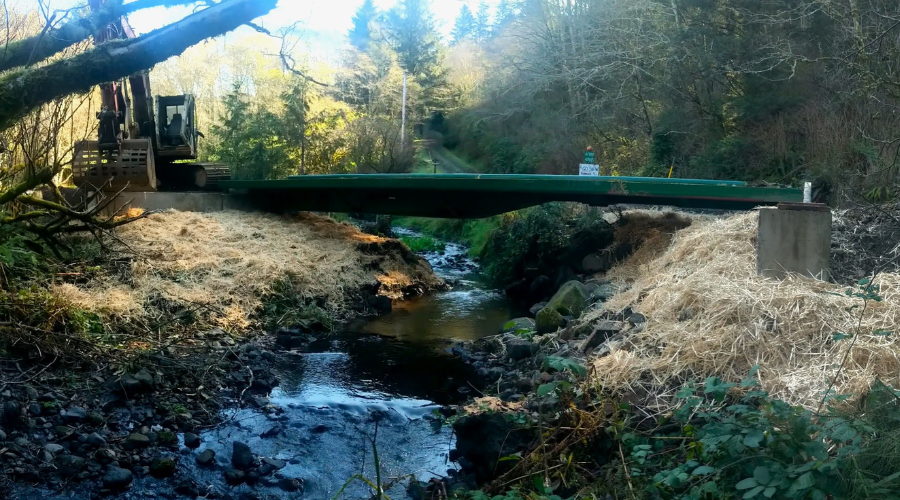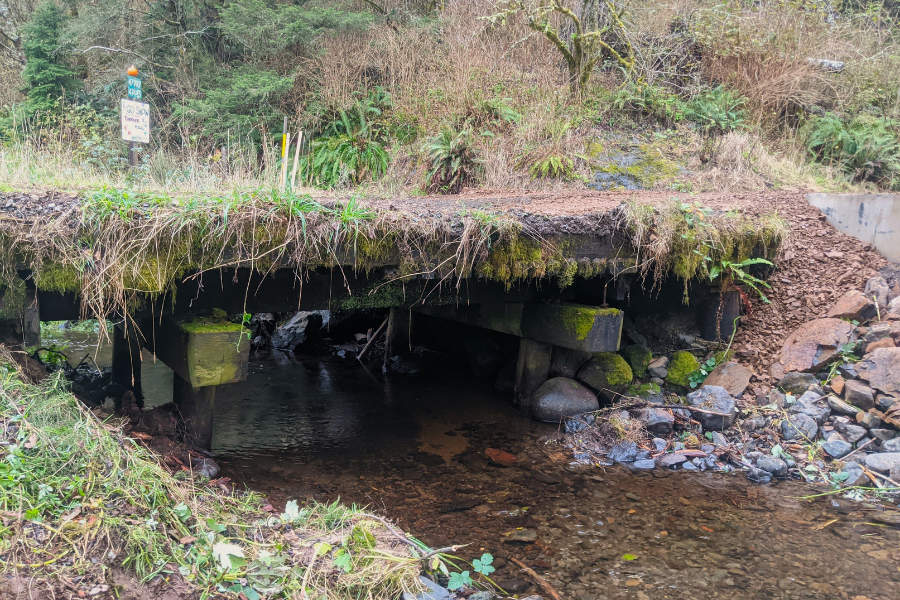
The new bridge at Butte Creek Habitat Reserve was installed Oct. 27.
In an effort to improve safety and fish habitat, North Coast Land Conservancy worked with local partners and neighbors to replace a bridge over Butte Creek in late October.
The bridge—located on NCLC’s Butte Creek Habitat Reserve in Tillamook County—was more than 50 years old and showing signs of significant wear. Neighbors who use the bridge to access their homes and properties on the other side of the reserve expressed concern that a major storm event could cause flooding and wash out the bridge. The bridge was impacted by the November 2021 storm, and concerns over its ability to withstand another arose. It also was not wide enough for emergency service vehicles to cross over.
Sue Gabriel, who donated two of the original parcels comprising the Butte Creek Habitat Reserve, referred to it as “Scary Bridge,” recalls NCLC Stewardship Director Melissa Reich.
Additionally, the old bridge rested on pilings that had been placed directly into parts of the Butte Creek, which was constricting the channel width and negatively impacting fish passage.
“If the bridge collapsed, which was inevitable eventually, it would have negative habitat impacts and also human-safety impacts,” Melissa says.

The old bridge at Butte Creek Habitat Reserve was more than 50 years old.
After hearing concerns from the neighbors, NCLC began looking for grant funding to help with the cost of the bridge replacement and reached out to the Nestucca, Neskowin & Sand Lake Watersheds Council. They procured a grant of approximately $82,000 from the Oregon Department of Fish and Wildlife (ODFW) to install a new, longer bridge that spans a more natural channel width, accommodating higher flows in winter without impacting fish passage.
In a collaborative spirit, neighbors of the reserve then pitched in donations for the remaining $10,000 to cover the total cost of the project. Meanwhile, the watersheds council managed the bridge replacement, as they’re currently working on another fish-passage project just downstream on the same creek. ODFW also has been an important partner, sending a fish biologist to attend neighbor meetings and offer consultation.
“Each entity in the project was really critical—we were all needed,” Melissa says, adding NCLC approaches projects “from a collaborative perspective whenever we can.”
This project not only gave NCLC the opportunity to work with the watersheds council for the first time, but they also got to know the neighbors of the Butte Creek Habitat Reserve better. Many land owners pitched in financially for the project and also assisted with research about the replacement bridge and offered storage and parking to one another during the actual installation phase.
“They’ve all been very supportive,” Melissa says. “It’s been a very collaborative process.”
With fall well underway—bringing heavy rains—the timing was optimal to get the bridge replaced. It is engineer-stamped for fire trucks to use to respond to emergencies on neighboring properties. Additionally, it doesn’t present barriers to fish passage in the creek and harm the habitat.
“Flood events were what everyone was concerned would wash out the bridge,” Melissa says. “From habitat and safety perspectives, it’s really great we can do it right now. And we’re really grateful to the watershed council and ODFW and all the neighbors and community for support. It’s been a lot of work and it’s been challenging, but it came together in a positive way.”
Comments